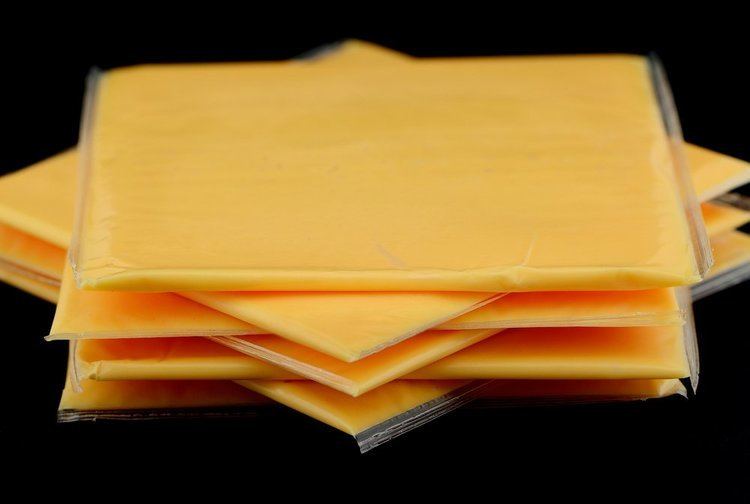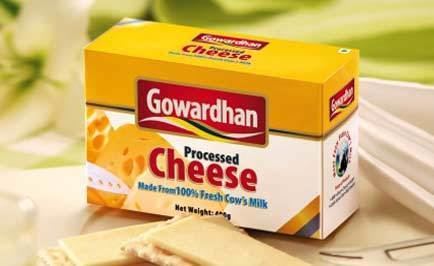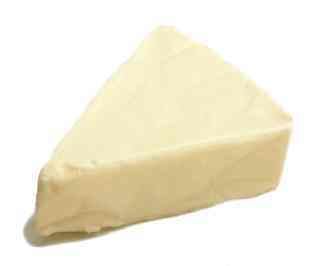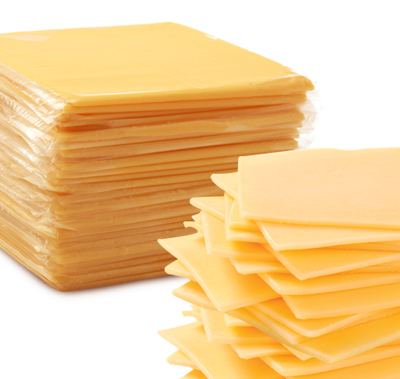 | ||
Similar Cheese, Cheddar cheese, Smetana, Quark, Camembert | ||
homemade processed cheese
Processed cheese (also known as prepared cheese, cheese product, plastic cheese, or cheese singles) is a food product made from cheese (and sometimes other, unfermented, dairy by-product ingredients), plus emulsifiers, saturated vegetable oils, extra salt, food colorings, whey or sugar. As a result, many flavors, colors, and textures of processed cheese exist. Its invention is credited to Walter Gerber of Thun, Switzerland, in 1911.
Contents
- homemade processed cheese
- Processed cheese meaning
- Advantages
- Sale and labeling
- United Kingdom
- United States
- Legal definitions
- References

Processed cheese meaning
Advantages

Processed cheese has several technical advantages over natural cheese, including a far longer shelf-life, resistance to separating when cooked, and a uniform look and physical behavior. Its mass-produced nature provides arguably its greatest advantage over natural cheese: a dramatically lower cost — to producers and consumers alike — than conventional cheesemaking. This, in turn, enables industrial-scale production volumes, lower distribution costs, a steadier supply, and much faster production time compared to traditional cheeses.

The use of emulsifiers in processed cheese results in a product that melts without separating when cooked; with prolonged heating, some natural cheeses (especially cheddar and mozzarella) separate into a lumpy, molten protein gel and liquid fat combination. The emulsifiers (typically sodium phosphate, potassium phosphate, tartrate, or citrate) reduce the tendency for tiny fat globules in the cheese to coalesce and pool on the surface.

Because processed cheese does not separate when melted, it is used as an ingredient in a variety of dishes. Unlike some unprocessed cheeses, heating does not alter its taste or texture.
Sale and labeling

Processed cheese is often sold in blocks, pressurized cans, and packs of individual slices, often separated by wax paper, or with each slice individually wrapped by machine.
United Kingdom

In the United Kingdom, processed cheese is typically sold in individually wrapped slices, often referred to as "singles", or in wax-wrapped portions. DairyLea and The Laughing Cow are leading brands.
United States

In 1916, James L. Kraft applied for the first U.S. patent for a method of making processed cheese. Kraft Foods developed the first commercially available, shelf-stable, sliced, processed cheese; it was introduced in 1950. This form of sliced cheese (and its derivatives) have become ubiquitous in U.S. households ever since, most notably used for cheeseburgers and grilled cheese sandwiches because of its ability to cook evenly, distribute/stretch smoothly, and resist congealing, unlike traditional cheddar cheeses. Competitors lobbied unsuccessfully to require processed cheese be labeled "embalmed cheese". The first commercially available, individually wrapped, cheese slices were introduced in the U.S. by Clearfield Cheese Co. in 1956. U.S. Patent 2759308 by Arnold Nawrocki was assigned to Clearfield Cheese Co. in 1956.
The best known processed cheese in the United States is marketed as American cheese by Kraft Foods, Borden, and other companies. It is orange, yellow, or off-white; mild, with a medium consistency; and melts easily. It is typically made from a blend of cheeses, most often Colby and cheddar. Another type of processed cheese created in the United States is Provel pasteurized processed pizza cheese, which uses cheddar, Swiss, and provolone cheeses as flavorants. Provel cheese is commonly used in St. Louis-style pizza. A third variety of processed pizza cheeses are mozzarella-like imitation processed cheeses, which are sometimes used in frozen pizzas.
Legal definitions
Owing to its highly mechanized (i.e., assembly line) methods of production, and additive ingredients (e.g., oils, salts, or colors), some softer varieties of processed cheese cannot legally be labeled as actual "cheese" in many countries, even those in which slightly harder varieties can be. Such products tend to be classified as "cheese food", "cheese spread", or "cheese product" (depending primarily on the amount of cheese, moisture, and milkfat present in the final product).
United States
In the United States, processed cheese is defined, categorized, and regulated by the Food and Drug Administration under the U.S. Code of Federal Regulations Title 21 (Food and Drugs), Section 133 (Cheeses and Cheese Related Products). Pasteurized process cheese can be made from a single cheese (solid, or powdered), or a blend of several cheeses. Cream, milk fat, water, salt, artificial color, oils (for consistency and texture), and spices may also be added. The mixture is heated with an emulsifier, poured into a mold, and allowed to cool. The definitions include:
The U.S. Food and Drug Administration does not maintain a standard of identity for "pasteurized prepared cheese product", a designation which particularly appears on many Kraft products. Nor does the FDA maintain a standard of identity for "pasteurized process cheese product" (emphasis on the trailing "Product"), a designation which appears particularly on many American store- and generic-branded singles. Products labeled as such may use milk protein concentrate (MPC) in the formulation, an ingredient which does not appear in the above FDA definitions. The desire to use inexpensive imported milk protein concentrate is noted as motivation for the introduction of these and similar terms, and for the relabeling of some products. After an FDA Warning Letter protesting Kraft's use of MPC in late-2002, some varieties of Kraft Singles formerly labeled "pasteurized process cheese food" became "pasteurized prepared cheese product", Velveeta was relabeled from "pasteurized process cheese spread" to "pasteurized prepared cheese product", and Easy Cheese from "pasteurized process cheese spread" to "pasteurized cheese snack".
